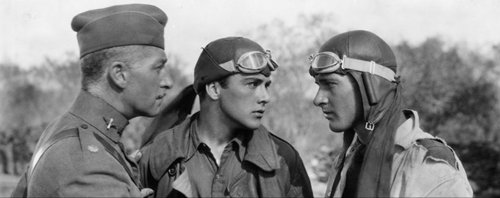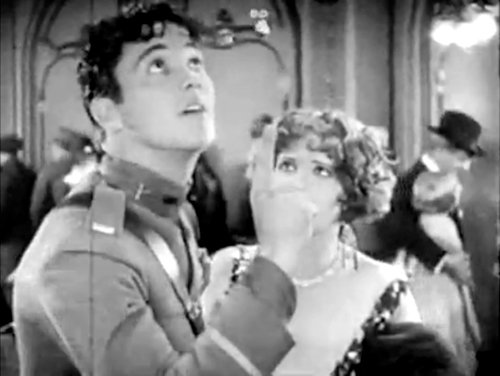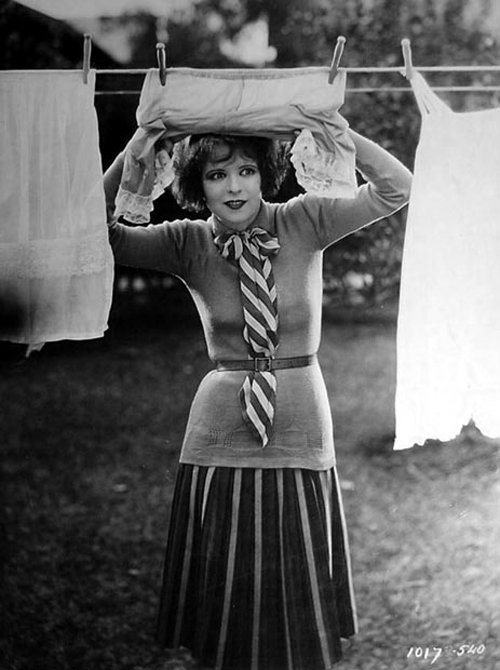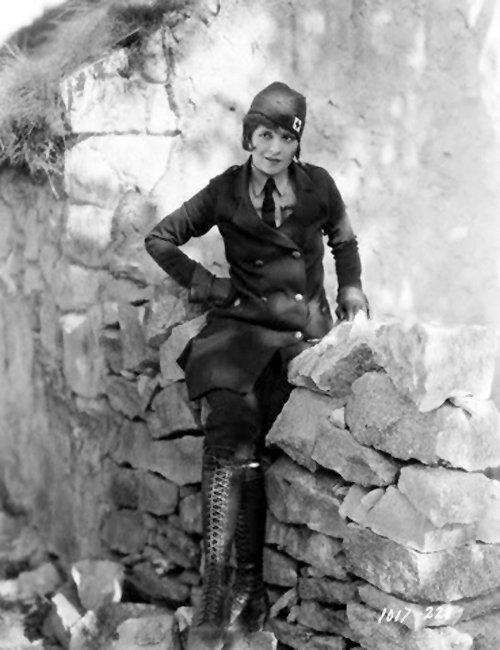Wings: A Review
 On Saturday I noticed by chance on Facebook that the Astor Theatre was showing a rare print of the 1927 film Wings, starring Clara Bow, with Charles ‘Buddy’ Rogers, and Richard Arlen. Gary Cooper appears in a role which helped launch his career in Hollywood and also marked the beginning of his affair with Clara Bow. [Wikipedia]
On Saturday I noticed by chance on Facebook that the Astor Theatre was showing a rare print of the 1927 film Wings, starring Clara Bow, with Charles ‘Buddy’ Rogers, and Richard Arlen. Gary Cooper appears in a role which helped launch his career in Hollywood and also marked the beginning of his affair with Clara Bow. [Wikipedia]
Originally released by Paramount Pictures, the film is a silent action film about World War 1 aviator pilot friends, and as Clara Bow stated, “Wings is … a man's picture and I’m just the whipped cream on top of the pie”. This is unfortunately true, but she is a delicious addition to the recipe.
 Charles ‘Buddy’ Rogers, Clara Bow and Richard Arlen
Charles ‘Buddy’ Rogers, Clara Bow and Richard Arlen It is the cinematography and aviation scenes that are the real stars in this film however. A number of the cast and crew had all served in WW1 as military aviators, so they were able to draw on this experience in the execution of these scenes. What makes it much more moving and suspenseful than modern films about WW1 is this fact: the war had ended only ten years earlier, and this brings such immediacy and verisimilitude to the action. There is also real footage from WW1 mixed in – creating a strange juxtaposition considering Wings is a fictionalised account. Watching it one is made soberly aware that some of these men are actually dying.
It is the cinematography and aviation scenes that are the real stars in this film however. A number of the cast and crew had all served in WW1 as military aviators, so they were able to draw on this experience in the execution of these scenes. What makes it much more moving and suspenseful than modern films about WW1 is this fact: the war had ended only ten years earlier, and this brings such immediacy and verisimilitude to the action. There is also real footage from WW1 mixed in – creating a strange juxtaposition considering Wings is a fictionalised account. Watching it one is made soberly aware that some of these men are actually dying.
 Albert Conti, Charles ‘Buddy’ Rogers, Richard Arlen
Albert Conti, Charles ‘Buddy’ Rogers, Richard Arlen Charles ‘Buddy’ Rogers; I was pleased to see some boxing action while the boys were at aviation training
Charles ‘Buddy’ Rogers; I was pleased to see some boxing action while the boys were at aviation training
Wings went on to win the first Academy Award for Best Picture, but the film was unfortunately subsequently lost – until it was found in the Cinémathèque Française film archive and was copied from nitrate film to safety film stock. The film was meticulously restored and released by Paramount on DVD in 2012, and the musical score was re-orchestrated.
The sound effects were recreated at Skywalker Sound using archived audio tracks – although of course there was no voice, the sound of motors and engines interspersed through the film added greatly to the dramatic tension created by the score. It is easy too to forget that silent films were not all necessarily purely black and white: Wings was colour tinted in sepia and cyanotype tones, as well as black. The scenes using the Handschiegl color process to give colour to explosions were also recreated for the restored version. [Wikipedia]
 Charles ‘Buddy’ Rogers and Clara Bow in the Folies Bergère and some bubble actionWatching the scenes set in Paris was fascinating from a cultural point of view, glimpsing the people in the streets – how they dressed, spoke (or gesticulated animatedly) and behaved – and of course the fashion was especially enjoyable for me. I loved the way Clara Bow wore her scarf: tied in a bow around her neck, and then tucked into her belt. (One to try at home!) And her uniform as an ambulance driver in the war was wonderful – those lace-up knee-high boots were fabulous. There was also a fantastic comic scene involving drunken behaviour and hallucinatory bubbles in the Folies Bergère, where Clara Bow came into her own (watch her shimmy here). And let’s not forget the male nudity, the first scenes where men kissed on screen, and a brief glimpse of Clara Bow’s breasts (which I missed).
Charles ‘Buddy’ Rogers and Clara Bow in the Folies Bergère and some bubble actionWatching the scenes set in Paris was fascinating from a cultural point of view, glimpsing the people in the streets – how they dressed, spoke (or gesticulated animatedly) and behaved – and of course the fashion was especially enjoyable for me. I loved the way Clara Bow wore her scarf: tied in a bow around her neck, and then tucked into her belt. (One to try at home!) And her uniform as an ambulance driver in the war was wonderful – those lace-up knee-high boots were fabulous. There was also a fantastic comic scene involving drunken behaviour and hallucinatory bubbles in the Folies Bergère, where Clara Bow came into her own (watch her shimmy here). And let’s not forget the male nudity, the first scenes where men kissed on screen, and a brief glimpse of Clara Bow’s breasts (which I missed).
 Twenties scarf action with Clara Bow in the back yard
Twenties scarf action with Clara Bow in the back yard Clara Bow in her ambulance driver’s uniform – check out those boots!On a final note, here’s an interesting piece of trivia: Wings was the only silent movie to win an Oscar for Best Picture – until the experimental film The Artist came along in 2011.
Clara Bow in her ambulance driver’s uniform – check out those boots!On a final note, here’s an interesting piece of trivia: Wings was the only silent movie to win an Oscar for Best Picture – until the experimental film The Artist came along in 2011.
Watch the film on DVD if you can, but it really should be seen on the big screen. Thank you Astor.
Read more here.
 Charles ‘Buddy’ Rogers and Clara Bow
Charles ‘Buddy’ Rogers and Clara Bow
Spring’s on the horizon!
 Sunday, 14 October, 2012 :: 20:43:49Spring is coming! The prospect makes me want to jump in sheer excitement. Supposedly laughter is the best medicine, but I reckon sunshine is pretty darned good too.
Sunday, 14 October, 2012 :: 20:43:49Spring is coming! The prospect makes me want to jump in sheer excitement. Supposedly laughter is the best medicine, but I reckon sunshine is pretty darned good too.
The horizon is clear
and halcyon blue
spring lightly
hand in hand
and fleet like deer, dear
we may race fast enough
to catch the glorious sun
and burn in its fire, and burn.
Monet’s Garden
 Waterlilies, 1919When I was at art college, it was considered unfashionable and bourgeois to like the Impressionists (and it’s probably still the case). Although I was never particularly a fan of the style, observing technique is always educational, and it is worth remembering that when they were alive, the Impressionist painters were considered outrageous rebels, perpetrating crimes against painting. So it was with an open mind I went to view the Winter Masterpieces exhibition Monet’s Garden, on at the National Gallery of Victoria (until 8 September).
Waterlilies, 1919When I was at art college, it was considered unfashionable and bourgeois to like the Impressionists (and it’s probably still the case). Although I was never particularly a fan of the style, observing technique is always educational, and it is worth remembering that when they were alive, the Impressionist painters were considered outrageous rebels, perpetrating crimes against painting. So it was with an open mind I went to view the Winter Masterpieces exhibition Monet’s Garden, on at the National Gallery of Victoria (until 8 September).
 Stormy Seascape, 1883I was pleasantly surprised by what a great job the curator did – it so often the case with exhibitions in Australia that only lesser-known paintings by great masters on view (due to the expense or reluctance of international museums or private collections to send artworks on such a long journey). There were several rooms devoted to different aspects of his work, including a wonderful semi-circular room at the very end showing a panoramic video of 24 hours in Monet’s house and garden, accompanied by beautiful music.
Stormy Seascape, 1883I was pleasantly surprised by what a great job the curator did – it so often the case with exhibitions in Australia that only lesser-known paintings by great masters on view (due to the expense or reluctance of international museums or private collections to send artworks on such a long journey). There were several rooms devoted to different aspects of his work, including a wonderful semi-circular room at the very end showing a panoramic video of 24 hours in Monet’s house and garden, accompanied by beautiful music.
 Waterlilies, 1908But I was even more impressed by Monet’s work – I had not studied his life and work probably since high school. And what a remarkable tour de force in painting! What a vision this man had, and such determination and passion – visible in every brushstroke is urgent need to capture moments in time, to capture the sheer breathtaking beauty of light, even when he almost lost his eyesight.
Waterlilies, 1908But I was even more impressed by Monet’s work – I had not studied his life and work probably since high school. And what a remarkable tour de force in painting! What a vision this man had, and such determination and passion – visible in every brushstroke is urgent need to capture moments in time, to capture the sheer breathtaking beauty of light, even when he almost lost his eyesight.
 Waterlilies, 1907His water lily paintings are so lovely and ethereal. The absence of land, the tilted plane influenced by the flatness of Japanese woodcuts, the reflections on the smooth surface of the water contrasting with the horizontal texture of the water lilies that float on the surface – all combine to create the dizzying illusion of depth, a mirror reflecting the real and yet turning that reality on its head.
Waterlilies, 1907His water lily paintings are so lovely and ethereal. The absence of land, the tilted plane influenced by the flatness of Japanese woodcuts, the reflections on the smooth surface of the water contrasting with the horizontal texture of the water lilies that float on the surface – all combine to create the dizzying illusion of depth, a mirror reflecting the real and yet turning that reality on its head.
 The Japanese Bridge, 1924Much has been said on the necessity of standing far back from Impressionist paintings so that the eye merges all the inexplicable dabs of paint, but the phenomenon is astonishing when one actually experiences it. It’s quite amazing to sit far back from his paintings of the Japanese bridge rendered in burnt sienna, red and gold. Standing directly in front, they are a mass of writhing brushstrokes forming almost indeterminate shapes, but ten metres away the dabs suddenly fuse, coalesce and one can see the path under the rose arbour. There is depth – through the centre and through the leaves of the trees overhead where one can glimpse the sky.
The Japanese Bridge, 1924Much has been said on the necessity of standing far back from Impressionist paintings so that the eye merges all the inexplicable dabs of paint, but the phenomenon is astonishing when one actually experiences it. It’s quite amazing to sit far back from his paintings of the Japanese bridge rendered in burnt sienna, red and gold. Standing directly in front, they are a mass of writhing brushstrokes forming almost indeterminate shapes, but ten metres away the dabs suddenly fuse, coalesce and one can see the path under the rose arbour. There is depth – through the centre and through the leaves of the trees overhead where one can glimpse the sky.
 The Rose Path, Giverny, 1922
The Rose Path, Giverny, 1922 Vétheuil in the fog, 1879Of his earlier paintings, my favourites were those where Monet explored atmospheric effects (always one of his favourite themes). Vétheuil in the fog (1879) remained one of Monet’s favourite paintings that he refused to sell, keeping it beside him all his life. Here he was determined to capture the atmospheric effects of fog on a view of the town across the water. It is ethereal, glimpse through the white mist. The single painting of Rouen Cathedral – one of 30 canvases he painted – captures bright and warm sunlight of late afternoon, blurred and shifting into shadows, a joyous celebration of paint and light.
Vétheuil in the fog, 1879Of his earlier paintings, my favourites were those where Monet explored atmospheric effects (always one of his favourite themes). Vétheuil in the fog (1879) remained one of Monet’s favourite paintings that he refused to sell, keeping it beside him all his life. Here he was determined to capture the atmospheric effects of fog on a view of the town across the water. It is ethereal, glimpse through the white mist. The single painting of Rouen Cathedral – one of 30 canvases he painted – captures bright and warm sunlight of late afternoon, blurred and shifting into shadows, a joyous celebration of paint and light.
 Rouen Cathedral, Effects of Sunlight, Sunset 1892I also particularly loved a long field of irises, painted with a palette of only five colours. Monet has done away with deep shadows and thus captured the brilliant and fresh air of a bright spring or summer morning. Field of yellow irises at Giverny (1887). The brushstrokes are almost sketchy; primed canvas is left exposed in the lower right corner. The angled brushstrokes seem also to capture the wind as it tosses the flowers and the clouds about.
Rouen Cathedral, Effects of Sunlight, Sunset 1892I also particularly loved a long field of irises, painted with a palette of only five colours. Monet has done away with deep shadows and thus captured the brilliant and fresh air of a bright spring or summer morning. Field of yellow irises at Giverny (1887). The brushstrokes are almost sketchy; primed canvas is left exposed in the lower right corner. The angled brushstrokes seem also to capture the wind as it tosses the flowers and the clouds about.
 Field of yellow irises at Giverny, 1887What all these paintings show is one man’s obsession with nature as a subject, and his passion and commitment in capturing it. It’s a rare opportunity to see such work in Australia – don’t miss it.
Field of yellow irises at Giverny, 1887What all these paintings show is one man’s obsession with nature as a subject, and his passion and commitment in capturing it. It’s a rare opportunity to see such work in Australia – don’t miss it.
Mini Zombies Cold
 Frankie calendar says it’s August. Where did the first half of the year go? The happy news is that it’s the last month of winter in Melbourne, hooray! These Little Ones look none too pleased though. Their expressions are so dour and cross I like to imagine they’re mini zombies, ready and willing to take over the world. Or maybe they’re just cold.
Frankie calendar says it’s August. Where did the first half of the year go? The happy news is that it’s the last month of winter in Melbourne, hooray! These Little Ones look none too pleased though. Their expressions are so dour and cross I like to imagine they’re mini zombies, ready and willing to take over the world. Or maybe they’re just cold.
The painting is by Jennifer Davis, an artist from Minneapolis, USA. See more of her work at her website, or buy some from her Etsy shop.
Smashing Ceramics
 Livia Marin’s series of Nomad Patterns and Broken Things are just sublime. Smashed ceramic vessels appear to be melting into pools of molten clay, puddling over the table surface. Made from ceramic, resin and plaster, they are transfer-printed with patterns in the classic Oriental blue and white style.
Livia Marin’s series of Nomad Patterns and Broken Things are just sublime. Smashed ceramic vessels appear to be melting into pools of molten clay, puddling over the table surface. Made from ceramic, resin and plaster, they are transfer-printed with patterns in the classic Oriental blue and white style.

 The London-based Chilean artist says of her work:
The London-based Chilean artist says of her work:
My artistic practice has been characterized by large-scale installations and the appropriation of mass-produced and consumer objects. I employ techniques and strategies that are characteristic of Sculpture, Installation and Process Art. I employ everyday objects to enquire into the nature of how we relate to material objects in an era dominated by mass-production, standardization and global circulation.
By appropriating mass-market objects I seek to offer through the work a reflection on how we particularize our relation to them. I reflect on how, in a secular and materialist society, identities are increasingly designated through the material tokens derived from consumerism.
Fascinating, beautiful and simply smashing.
See more of Marin’s work on her website, and read an interview with her at Underline Gallery.




